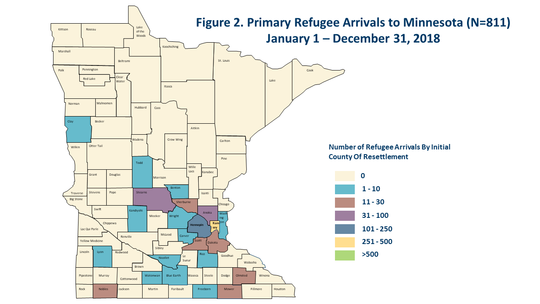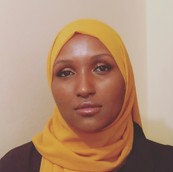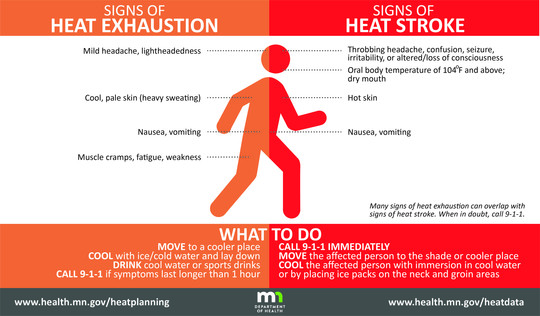|
From January 1, 2018, through December 31, 2018, 811 primary refugees resettled in Minnesota.* This represented a 26% decrease in the number of arrivals compared to 2017, when 1,103 refugees resettled in Minnesota, and a 75% decrease in the number of arrivals compared to 2016, when 3,186 resettled in Minnesota.
Among the 811 primary refugee arrivals, 39% were from Burma, 13% were from Ethiopia, 10% were from the Democratic Republic of Congo, 9% were from Somalia, and the remaining 30% were from 28 other countries (Figure 1).
 *2018 data are preliminary
Fifty-five percent of primary refugees resettled in Ramsey County, 14% resettled in Hennepin County, 5% resettled in Anoka County, 4% resettled in Stearns County, and the remaining 22% resettled in 19 other counties across Minnesota (Figure 2).
 *2018 data are preliminary
Nationally, from October 1, 2017 - September 30, 2018, 22,491 refugees resettled in the U.S. (source: Department of State, Bureau of Population, Refugees, and Migration, RPC: Admissions & Arrivals). This represented a 58% decrease in refugee arrivals in the U.S. compared to October 1, 2016 - September 30, 2017 (53,716 refugees), and a 74% decrease compared to October 1, 2015 - September 30, 2016 (84,994 refugees). From October 1, 2018 - May 31, 2019, 18,051 refugees resettled in the U.S.
The United Nations High Commissioner for Refugees (UNHCR) has released its Global Trends: Forced Displacement in 2018 report. They estimate there are 70.8 million forcibly displaced persons worldwide, including 25.9 million refugees. More than two-thirds of refugees worldwide came from just five countries: Syria, Afghanistan, South Sudan, Myanmar (Burma), and Somalia. Only 92,400 refugees were resettled in a third country during 2018.
Our Minnesota refugee resettlement programs rely on dedicated and passionate volunteers to welcome and walk with our new arrivals to Minnesota as they build their lives in communities here. Kathryn Berger, the Outreach and Volunteer Specialist at the Minnesota Council of Churches (MCC), says their volunteers “do things WITH people, not FOR them.”
MCC is an interfaith organization with the mission of bringing about unity built on justice. It is comprised of 25 denomination heads from diverse churches whose members total over 1 million people. Kathryn reaches out to these churches and others through MCC Refugee Services, bringing people together to welcome those fleeing persecution. MCC’s volunteers include individuals, “co-sponsor” groups, befrienders, bus mentors, Bridging home furnishings shoppers, in-home English language and cultural orientation tutors, and a Refugee Speakers Bureau.

One of MCC’s stellar volunteers is Nafisa Mohamed. She is compassionate, bright, and thrilled to be working with refugees. When Kathryn asked her what she wanted to do or who she wanted to work with, Nafisa said, “Anyone and anything so I get to learn more!” She seems to have endless energy: she works full-time as a nursing assistant at the Veteran’s Home in Minneapolis and is attending the two-year nursing program at Minneapolis College with plans to eventually get a four-year nursing degree. At MCC, Nafisa spends about six hours each week teaching people wide-ranging skills for life in the U.S., such as how to ride the bus, pay bills, get phone cards, register for English language classes, get a library card and use the library. She also does some interpreting.
|
Nafisa opens her door to family, friends, strangers, and community agencies with whom she is very well-connected. She is a mentor, caregiver, and friend to anyone struggling with the stress of everyday life. Her openness and generosity comes from gratitude for those who have been there for her. Nafisa is brief when talking about her own difficulties arriving in the U.S. as a teenager with refugee status in the mid-1990s; she chooses to focus on how well life is going for her now. “It’s like living my dream,” she says. In the midst of this very full life, when asked why she wanted to volunteer at MCC, Nafisa simply said: “It just feels natural.”
So, if volunteering feels natural for you as well, or if you are courageous enough to step up and share part of your life with our newest Minnesotans, consider being a volunteer. Visit MDH: Resettlement for more information about the various resettlement agencies and volunteer programs in Minnesota.
The MDH Refugee and International Health Program is collaborating with the MDH Climate and Health Program to develop and disseminate timely and accessible information for refugee and immigrant communities and those with limited English proficiency to prevent serious illness.
The Climate and Health Program focuses on improving our ability to protect public health and prevent further harms from climate change. They do this by engaging, informing, and guiding health and climate champions throughout our state to create healthy, equitable, and resilient communities. The program has identified three priority areas for community members based on the level of concern and our ability to protect ourselves: extreme heat, diseases spread by ticks and mosquitoes, and air quality.
Extreme heat events in Minnesota are expected to become more common, more severe, and longer-lasting. Extreme heat events can be dangerous to health—even fatal. Children, people exercising outside, people working outdoors, and people without air conditioning are most at risk.
On hot days, take care of yourself and your family. Check in on neighbors who are older adults, have health problems, or do not have air conditioning. Be sure to drink lots of water. Take breaks to rest, and spend time in air-conditioned places such as libraries or shopping malls if possible. Take cool showers or baths. Never leave a child, adult, or animal inside a car on a hot (or even warm) day. Be aware of signs of heat exhaustion or heat stroke, so you can call 911 if necessary (see graphic below).
In future editions, we will highlight other priority health areas. Visit MDH: Extreme Heat Events to access more information and translated materials on extreme heat and learn more about MDH Climate and Health Program initiatives.

The Centers for Disease Control and Prevention (CDC) provides guidelines for the health assessment of newly arrived refugees on its website. These guidelines are lengthy and intended to be comprehensive, so identifying the recommendations relevant to a specific patient is time-consuming. This can be intimidating to health care providers who work with refugees infrequently, and impractical when a provider is with a patient in the clinic. Our Minnesota Center for Excellence in Refugee Health, funded by CDC, recently developed CareRef, a web-based tool to assist health care providers in screening newly arrived refugees.
CareRef allows health care providers conducting the U.S. Domestic Medical Examination for Newly Arrived Refugees to input demographic information, along with overseas screening results and interventions for their refugee patient. CareRef then provides the CDC screening guidance relevant for that individual. This includes recommended labs, immunizations, physical exam components, and mental health evaluation, among others. CareRef also displays any relevant health alerts issued by CDC, links to population-specific health profiles, and links to translated educational materials for patients.
A 2018 survey of clinicians who conduct the refugee health assessment found that 86% believed CareRef would be useful in their practice. Many also said it would be useful as a tool for training new providers.
CareRef: Clinical Assessment for Refugees
We invite everyone to join us at Twin Cities World Refugee Day to celebrate refugees in our communities and learn about the work of the RIHP and many other organizations.
Date: Sunday, July 14, 2019
Time: 2:00 - 7:00 p.m.
Location: Loring Park | 1382 Willow St | Minneapolis, MN 55403
|